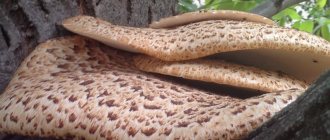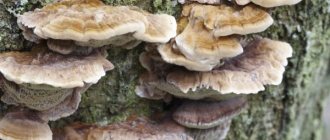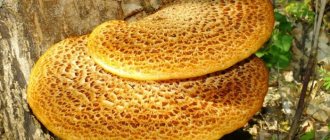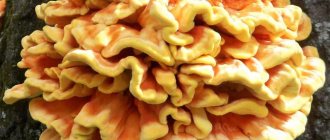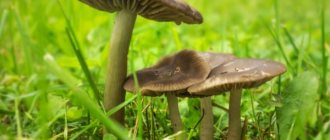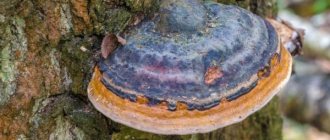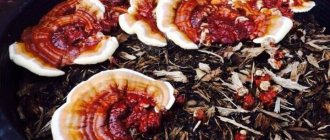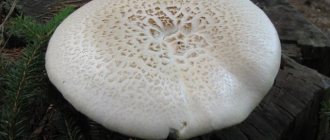About one of the most delicious and aromatic representatives of the tree mushroom family - Scaly tinder fungus. The area and timing of its growth, nutritional and medicinal properties, and the technology for preparing this mushroom for consumption.
Walking through the Russian forest, you can often come across funny half-plates that seem to have grown into tree trunks. They can grow singly or piled on top of each other in tall, multi-tiered structures. These are tinder fungi - wood fungi - parasites. There are many species of them, and they are all similar to each other, but one of the types of tinder fungus is difficult to confuse with its fellows because of its pronounced individual coloring, this
Scaly tinder fungus - a spotted woody delicacy
The scaly polypore or Cerioporus Squamosus from the genus Cerioporus, family Polyporaceae is a conditionally edible mushroom, valued by many lovers for its delicate taste and aroma. This mushroom is also called the Variegated Polypore, and among the people it has many traditional nicknames - Hare, Spotted, Vyazovik, Pestrushka.
Appearance
Scaly tinder fungus is a spotted woody delicacy.
The cap is juicy, fleshy, about 30-40 cm in diameter, kidney-shaped in youth, later spread out, with a slight depression in the center and thin, wavy, curved - drooping edges. The color of the cap is yellowish-grayish, and on top it is covered with characteristic dark brown scales arranged in symmetrical circles - waves.
The hymenophore is tubular type, light yellowish, with angular, large cells. White spore powder.
The leg is short and thick, up to 10 cm long, up to 4 cm wide, and has a lateral or eccentric location. The color of the leg is the same as that of the cap, darker at the base, and it is also covered with brown scales.
The pulp of young specimens is white-cream in color, dense and juicy, smelling incredibly pleasantly of pastry or honey. In old fruiting bodies, the pulp becomes wooden-hard, therefore, it is usually not eaten, but retains its edibility and pleasant smell.
Where and When It Grows
Scaly tinder fungus is a spotted woody delicacy.
Haretail grows from May to early autumn. It settles on the trunks of old elms, maples, poplars and acacias. It usually reaches its most impressive sizes on maples, but on acacias, on the contrary, it grows small and sluggish. This fungus is, in fact, a disease - it settles in places where the tree bark is damaged and continues to destroy it, contributing to the appearance of white and yellow stem rot. This type of tinder fungus is found in deciduous forests and parks throughout Europe and eastern North America. In Russia, it is more often found in the southern regions. It can appear on trunks either singly or in numerous families, then its caps hang over each other, like tiles on a roof.
The Scaly tinder fungus usually does not climb too high along the trunk - a maximum of 10 -12 m from the ground, and can even grow almost close to the ground.
What kind of mushrooms grow on a walnut tree?
Are they edible?
These mushrooms are called tinder fungi, or their other name is Devil's Hooves. They interfere with the fruiting of trees and destroy their bark. To destroy them, you need to cut off the fruits of the tinder fungus and burn it, and treat the wounds that remain on the tree with a solution of 3% copper sulfate or garden varnish (petralatum or carbolineum). If the tree has foliage, you can spray it with Bordeaux mixture for prevention.
The tinder fungus has been a tree for 6-10 years, so there is enough time to eliminate it; you just need to notice the parasite in time.
We have a lot of walnuts in our village and I also saw something like mushrooms on a couple of trees. Usually these are tinder fungi, which are parasitic fungi; they cannot be consumed. And it is advisable to remove them so that the tree does not die and very carefully so that the spores do not fly away. I don’t know about edible mushrooms, you need to look at the photo.
Mushrooms do grow on the trunk of a walnut, but the only thing is that they are usually tinder fungi, and they correspond to parasitic mushrooms. They usually appear on very old trees. I would not recommend eating unfamiliar mushrooms.
Various mushrooms, both edible and not so, can grow on the trunk of a walnut tree. For example, winter honey fungus or oyster mushroom can easily be seen on a nut - both mushrooms are edible. However, most often the parasitic fungus on the trunk of this tree is the tinder fungus. At first it does not cause much harm to the plant, but then it reduces its productivity. I think it is better not to eat unknown mushrooms - there is no need for this.
Culinary Use
Scaly tinder fungus is a spotted woody delicacy
. Although this mushroom officially belongs only to the fourth food category, Zayachnik enjoys a well-deserved reputation as a mushroom delicacy for its delicate taste and exquisite smell of young fruiting bodies. It is successfully fried, soups are made from it, and it is also salted and pickled. In Udmurtia, this mushroom is called mekangubi, and is eaten without any prior boiling. However, we must remember that the Scaly Polypore is still classified as a conditionally edible mushroom, and there are certain rules for using it in food:
- Only young fruiting bodies need to be collected. It’s not difficult to check the age - pinch the edge of the cap - if it breaks and crumbles, you can eat it.
- The collected fruiting bodies must be soaked in water. Some people soak it for a whole day, but a couple of hours is enough. If you soak for a long time, then periodically change the water to fresh water. Then the mushrooms need to be boiled for 15 minutes - after which you can use them for culinary purposes as you please. The resulting broth can be used for soup.
- For cooking, they usually use the flesh of the cap, peeling off the skin and scales, but the legs are also edible.
The main thing is not to overcook. If boiled for too long, the flesh of the tinder fungus loses its taste and aroma, and you may end up with something that resembles chewed rubber.
Scaly tinder fungus is a spotted woody delicacy.
Tinder fungus is easy to prepare for future use:
Sun drying
- Clean the fruit bodies from dirt and damaged fragments and wipe with a damp cloth.
- Cut into medium sized pieces.
- Thread onto a thread, making sure that the pieces do not touch each other.
- Hang to dry in a sunny place. You can lightly cover the pieces with a layer of gauze on top to protect them from insects.
Salting for the winter
Required:
- Salt – 120 gr.
- Peeled and boiled mushrooms – 3 kg.
- Garlic – 5-6 medium sized cloves.
- Bay leaf – 6 pieces.
- Black peppercorns - about 30 pieces.
- Dill to taste.
The ingredients are placed in the pickling container in this order:
- Chopped garlic, bay leaf, dill and black pepper.
- Mushrooms in a 7 cm layer, then cover them with salt.
- Repeat this combination of layers until the edge of the container.
- Cover the top with a thick napkin, place under a load and put away in a dark place for a month.
Use in medicine, medicinal properties
- The medicinal properties of the sulfur-yellow tinder fungus are as follows:
- Improving the functioning of the cardiovascular system.
- Lowers blood glucose, which helps regulate sugar and reduce symptoms of diabetes.
- Helps with constipation, as it has a laxative property.
- Strengthening the immune system.
- Acceleration of tissue regeneration.
- Elimination of symptoms of peptic ulcer of the digestive system
- Provoking the death of bacteria that contribute to the development of gastritis.
- Treatment of tuberculosis.
- Avitaminosis.
The benefits of the product have a positive effect on men's health . Eating tinder helps them get rid of impotence and prostatitis. If women eat mushrooms, then beneficial enzymes will help reduce the symptoms of menopause.
In medicine, the use of sulfur-yellow polypore is quite common. Since it contains a huge amount of polysaccharides, it is possible to reduce the development of cancerous tumors . The presence of glucans helps neutralize heavy metals. This type of mushroom is used as the main ingredient for ointments and tinctures, which are characterized by anti-inflammatory effects. Antibiotics are also prepared from it .
Traditional medicine recipes
Often, recipes from tinder fungus are used to treat lung diseases . This will require 1 tbsp. l. mushroom powder (first you need to dry the mushrooms and then grind them in a mortar) and 200 ml of boiled water (temperature from +30°C to +35°C).
The cooking process is as follows:
- Mix water and powder.
- Cook in a water bath for 30 minutes.
- Leave to cool at room temperature.
You need to consume the mixture 4 times a day, 1 tbsp.
l. Use for a week during signs of pneumonia or bronchitis. The shelf life of the mixture is 3-4 days. Should be stored at room temperature. If you have wounds or ulcers on your skin, then a tincture of mushroom powder will speed up their healing.
The cooking process is as follows:
- Mix 2 tsp. powder and 150 ml of alcohol or vodka.
- Pour the mixture into an opaque container and cover with a lid.
- Place in a dark place at room temperature for 14 days.
- Strain the infusion.
Apply the prepared medicine to the affected areas of the skin 2-3 times a day.
For convenience, you can pour the tincture into a container with a spray bottle. You need to store it in the refrigerator for no more than 7 days. If you suffer from chronic constipation, then a decoction of tinder fungus will help you cope with it.
You can prepare it as follows:
- Mix 1 tbsp. mushrooms and 500 ml boiling water.
- Place ingredients in a saucepan and bring to a boil.
- Reduce the heat and then simmer the mixture for 30 minutes.
- Wrap the container in warm clothes and leave for 2-3 hours.
Saving lives
The pulp of the Scaly Polypore is also edible in old, woody fruiting bodies. In normal life, no one would think of eating it. But life is not always normal. During times of war and famine, enemy invasions and partisan warfare in the forests, people collected tinder fungi, ground them, and cooked something like mushroom soup from the hares.
Scaly tinder fungus - a spotted woody delicacy
Features of wood mushrooms
Many types of tree mushrooms act as forest health workers, since they are bred on weakened trees and help the natural selection of quality species. Representatives of such “orderlies” known to us, for example, are honey mushrooms, which grow beautifully on stumps in a large family and attract mushroom hunters with a spicy aroma. In addition, they are tasty, crispy, and are especially loved by gourmets when marinated.
But there are mushrooms that are completely different from traditional ones; they have neither a cap nor a stem. They are qualified and recognized by their shape and appearance, which reminds us of things familiar in everyday life. It never occurred to anyone to collect them and taste them, so the taste qualities of these eccentric specimens are not known for certain.
Such xylotrophs can be distinguished by a description of their appearance:
- Meat pieces (Askokorine meat);
- Resin in the form of a drop (Exidia ferruginosa);
- Bubble foam (Dacrimitses vanidas);
- Corals, sponge (Kalocera).
Even among mushrooms there are parasites that eat their relatives. For example, the sulfur-yellow hypocrea, which feeds on colonies of exidia or tremors.
Particularly dangerous parasites for forests include northern Climacodon, a representative of the subspecies Polypores. It penetrates into the body of a healthy tree through cracks and cuts and completely destroys it within 4 years.
Gardeners and park workers should be wary of such parasites, because they can completely destroy the garden.
Artificial Growing
The Scaly tinder fungus, due to its delicious taste, is often grown under artificial conditions, especially since it is not at all difficult.
Required:
- Polypore mycelium, which you can buy specially, or grow yourself using spore powder of fresh mushrooms.
- The substrate can be stumps or logs of maple, poplar or elm, as well as a mixture of sawdust and tree bark.
Growing:
- Pour boiling water over the substrate and then cool. If you use logs, they need to be soaked in water for two days.
- Squeeze out the substrate mixture and place it in a plastic bag, then add the mycelium there. If you are using logs, make shallow cuts in them and rub the mycelium into them.
- An incision must be made on the bag with the substrate and mycelium.
- Place the bag with the substrate or logs infected with mycelium in a room with a temperature of about 20 degrees and a humidity of no more than 70 -80%.
After 30-40 days, the first fruiting bodies will appear.
Similar Species
The appearance of the Scaly Polypore is quite unique, and it is difficult to confuse it with other representatives of the tinder family.
Polyporus tuberaster
Polyporus tuberaster
The only tinder fungus that looks similar to our hero is the similar coloring of the cap and the same concentric brown scales. But it is distinguished by a much more modest size - the cap is up to 20 cm, and the places where it grows - the tuberous polypore grows on the remains of deciduous trees, especially preferring linden. It is also edible at a young age, but has neither a special taste nor a pronounced aroma. This mushroom has a special connection with the Scaly tinder fungus, since previously it was he who bore this name, and then mycologists changed their minds, renamed it tuberous tinder fungus, and gave the former name to our hero.
Polypore Lumpy Daedaleopsis Confragosa
Polypore Lumpy Daedaleopsis Confragosa
It is similar to the Hare only in shape and habitat. It is smaller in size - up to 18 cm, has a woody-brown cap without scales, and bitter, odorless flesh. Due to its bitterness, it is considered unfit for food.
Treating a tree for fungi
Having penetrated walnut wood, the scaly tinder fungus decomposes it, turning it into white-yellow dust. However, even this is not a reason to panic. The tree can be completely cured. Early spring is most suitable for this. Under no circumstances should you carry out the following procedures while tying and filling nuts - the toxic substances used may transfer into them.
The areas affected by the fungus must be cleaned back to healthy wood using a sharp knife or chisel. The surface should be smooth and slightly concave. It must be treated with a 5% solution of copper sulfate, and after the wood has dried, it should be coated with oil paint or garden varnish. However, the most effective is petrolatum putty, consisting of 80% petrolatum, as well as (10% each) rosin and any vegetable oil. This composition most contributes to the healing and healing of wounds.
During the growing season, it is recommended to spray trees with Bordeaux mixture, and in the fall after leaf fall and in early spring - with a 5% solution of copper sulfate.
Healing uses
Polypores are rich in useful substances and have long been used in folk and official medicine.
Substances contained in the Scaly Polypore:
- They are used to cleanse the body of toxic substances, heavy metals and poisons.
- They have hemostatic, anti-inflammatory and antiseptic effects.
- Helps in the fight against nail fungus.
- They restore metabolism in the body, counteract the process of formation of adipose tissue, therefore they are often used in dietary programs.
Edibility of tinder fungus
This is a category 4 mushroom, edible only when young. In some mountain villages (in particular in Georgia and the Krpatsky region of Ukraine), the variegated tinder fungus is considered the best early spring mushroom. Some naturalists talk about the universal use of this mushroom: fresh (i.e. freshly fried, stewed, etc.), salted, pickled, dried, and they say that minced mushroom from the tinder fungus is a tasty filling for pies. It is better to use only freshly prepared ones in early spring, when there are no other mushrooms in nature, because its nutritional value is quite low, and there is no point in preparing it for future use (but this is purely my opinion!
A young mushroom is edible, but an old one turns into a piece of unchewable rubber. It is not difficult to determine the age of a mushroom; when cutting a young mushroom, a knife cuts like butter, but an old one is difficult to cut - it is better to throw it away immediately. Due to its specific appearance, both the shape and size of the cap, and its “scaly” surface, the scaly tinder fungus cannot be confused with other mushrooms.
What and how does the tinder fungus feed?
Polypores are a unique group of fungi. If most representatives of this kingdom feed only on dead plants, settling on the wood of rotten and fallen trees, then the tinder fungus is a parasitic fungus that lives on living, healthy trees. Different types of these fungi settle on tree trunks and over several years penetrate inside with mycelial shoots. Thus, the tinder fungus literally sucks water and nutritional components from the wood - it feeds on substances that are synthesized in birch, aspen or other wood. As a result, it begins to die and after a few years rots.
How does the tinder fungus grow?
This type of relationship does not end even after the death of the plant. When the tree has finally died, the tinder fungus continues to live in it, destroying the already dead remains. Spores develop under the fruiting body of the fungus, which are carried away by the wind and infect new trees - this is the life cycle of this parasitic organism. For trees, tinder fungus is harmful because it literally sucks water and organic matter from the wood. The process takes many years, so the effect is not immediately noticeable.
As a result, the plant dries out and becomes fragile, as a result of which, after a small hurricane, it breaks and falls to the ground along with the tinder fungus, which continues to feed on it. However, even such seemingly harmful activities bring benefits. By killing old trees, tinder fungi make room in the forest for new ones, and thus, in a sense, they can be considered the orderlies of the forest. The mushroom is also useful for its chemical composition - many of its species are used in folk medicine to treat various diseases.
Contraindications
This mushroom has no special contraindications, so standard safety rules for conditionally edible mushrooms apply to it.
- Not recommended for pregnant and lactating women.
- May cause complications in people with urolithiasis, chronic or acute gastrointestinal diseases.
- May cause an individual allergic reaction.
The Scaly tinder fungus is one of the most aromatic and tasty representatives of the tinder fungus family. Many lovers of quiet hunting are accustomed to ignoring tinder fungi, but those who are privy to the secret of the delicate aroma and taste of this inconspicuous tree inhabitant will never deny themselves the pleasure of enjoying them again.
